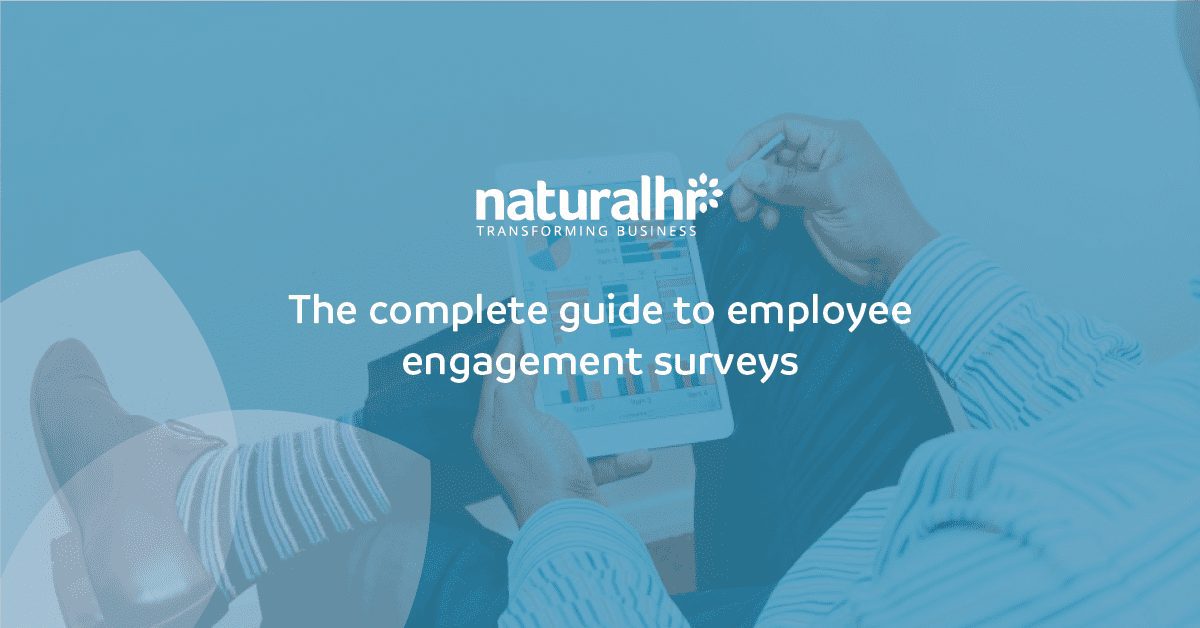
If you cast your memory back several years, you’ll remember employee engagement and culture was merely considered a popular topic for HR professionals to debate.
Fast forward to the present day, culture and engagement are now presented as a key business issue, with many believing it has recently dominated the HR trend list.
In fact, Deloitte Insights found that 87% of organisations cite culture and engagement as one of their top challenges, with 50% of respondents calling the problem “very important”.
While improving employee engagement can help build the right path towards a thriving company culture, it’s only one piece of the jigsaw. That’s why HR professionals need to perfect engagement, to ensure their employees are entirely connected in their place of work, before exploring the midst of organisational culture.
So, we’ve crafted a complete guide to employee engagement surveys, which will enable you to gain deeper insights into what drives engagement in your organisation – and what could possibly be hindering the process.
What is employee engagement?
Employee engagement is related to the levels of commitment and enthusiasm employees have towards their organisation and their individual goals set. In essence, it measures how motivated staff members are to go the extra mile for their colleagues and the organisation as a whole, showing just how devoted they are.
Many HR professionals believe employee engagement is about happiness and satisfaction levels. However, it’s much more than that. You can comfortably have a handful of people who are happy and satisfied at work, but that doesn’t mean they are working hard or being productive day-in-day-out.
To really tell if they are engaged, you need to see their loyalty levels down to their core, meaning you can recognise if an employee is not working just for their pay check, or wait around for the next opportunity to climb the ladder, it’s all about an employee wanting to work on behalf of the organisation towards its goals.
What is the purpose of engagement surveys?
In having a highly engaged workforce, there are going to be many benefits that relate towards not only the individual but the organisation as a whole. By mastering the art of engagement surveys, you’ll soon find an increase in retention, financial performance and brand reputation. Employees will feel more energised, maintain better mental health and be driven to provide consistent performances.
Importantly, employee engagement surveys will help you understand outcomes better. This is because you’ll obtain the right information, so you can begin impacting an employee to become more driven and happier, while releasing the factors that have prevented this happening in the first place.
From a Human Resources standpoint, employees who have good quality jobs and are managed well, will not only become happier, healthier and more fulfilled, but radiate productivity that impacts the innovation of everyone around them.
Anonymous vs confidential employee surveys
In a world that is driven by data protection, to get the most out of your employee engagement surveys, it’s important you remember to protect your employees right to privacy.
However, a key assumption of any successful survey, including employee engagement, is that all employees will complete it, let alone answer all questions honestly. That’s why employee must understand that they can share feedback in a confidential manner, dependent on their preference.
Anonymous
Conducting an anonymous survey will involve no employee data, meaning the responses are not related to any employee records. The respondents will have to tag themselves based on their own demographic, which can involve questions based on age, gender, job level and more.
Pros:
- No fear or embracement worries
- Better response rates
- Provides identify protection
- More honest feedback
Cons:
- No follow up process
- Feedback is likely to be less specific
- True answers may be avoided
- Hard to understand the full picture
Confidential
In this instance, employee data will be provided, meaning that the survey will be tied back to an employee record, and any demographic information sorted will be tagged directly to the individual.
Pros:
- Analyse feedback further
- Pinpoint problems directly to departments
- Better quality data
- Accurate response rates
Cons:
- Employees may not open up enough
- Worry about feedback being shared to line managers
- Could present trust issues
- Tweaked results
In terms of what survey, you should use is entirely down to you, however, in using a confidential employee engagement process, you are more inclined to generate accurate data that you can analyse to help make more of an impact and change within the organisation.
The data behind employee engagement surveys
According to the Harvard Business Review, employee surveys are still one of the best ways to measure engagement because they’re an ideal way to understand the behaviour of your workforce, providing employees with the chance to feel heard. Importantly, they help HR understand what drives engagement best within the organisation.
It’s no secret that by using data and analytics, HR can begin helping their employees to lead a better work-life balance, and part of this will involve integrating employee engagement into the workplace and using specific insights gained to create a better experience for everyone.
They do so by identifying and adjusting any weaknesses, building on strengths and continuing to push the experience by turning survey results into opportunities. To provide a clearer picture of how this is done, check out some of these engrossing stats.
- Provided with the chance to monitor engagement levels and take action, 80% of managers actively follow up on any issues raised.
- Engaged employees outperform their peers that are not engaged, with companies that have high engagement levels being 21% more profitable.
- 85% of HR executives consider employee experience and engagement as a valuable metric, but despite this, only 24% are prioritising the quality of the experience journey.
- Organisations that don’t take employee engagement surveys or act on feedback obtained only score 27% on the employee engagement index.
- 91% of 1,000 employees say their managers lack critical skills with 57% respondents citing ‘not giving clear directions’ as the biggest communication issue, which can be overcome by engagement surveys.
How to conduct an employee engagement survey
- Understand your current engagement levels
Like any project, you can’t just dive right into the deep end. You’ll first have to put some careful thought into the process, and this involves understanding where your organisation stands with its current engagement levels.
To do this, bring together a group of leaders or start collecting employee feedback and direct a few questions to gain a wider picture.
- From 1-10, how engaged do you feel in the workplace?
- Do you feel motivated and driven each day?
- Is there anything you’d change about your job?
- How’s the communication within your team?
- What is your driving factor when you wake up in the morning?
- Would you change your job or career for higher pay?
Although you won’t be able to fully understand engagement levels in its entirety, you’ll have some rich primary data that can help you set objectives further down the line.
- Acquire your dream team
It’s important to keep the interest of your employees at the forefront of this process the whole time, so it could be beneficial to involve leaders within the organisation who are advocates for increasing employee engagement.
You should continue to ask them about the state of the organisation’s current engagement levels and use the findings from the initial quiz to see if it aligns with their current picture and vision for the future. In doing so, you’ll have a better understanding of the areas which need the most attention.
- What outcomes do you want to achieve?
Now you’ve gained a rough idea of where your engagement levels are at, work together with your dream team to set clear, but realistic expectations of what you’d like to achieve from the employee engagement surveys.
This will, of course, depend on where you currently stand and if there are any obstacles in the way which could prevent you from achieving the objective.
- Increase employee retention
- Improve workforce productivity
- Smooth flow of communication
- Transform company culture
- Align objectives with question
Got your objectives in mind? Proceed by creating a list of engaging questions which allow you to gain further insight into areas such as company culture, personal development areas, employee morals and more.
Don’t worry if you can’t collate all your questions at once; we’ll help you out with that later.
- How are you going to conduct the survey?
So, you’ve got most of the survey planned out in your head, but how exactly do you intend to push the survey out? It’s time to determine how you want to conduct the survey and share the findings moving forward.
With Natural HR’s all-in-one HR and payroll software, you can give your team a voice with intuitive engagement surveys and gather feedback to gain actionable data based on your employees’ morale.
The integrated employee engagement tools allow you to track engagement over periods of time and pin-point areas for personal growth and development by using employee pulse, surveys and competency boards.
- Analyse key findings
Once you’ve pushed out your preferred method of engagement, you’ll then need to examine the results. From the data gathered, you should be able to detect trends or certain patterns which are affecting progression, morale, communication and more.
With Natural HR, you can provide managers with real-time, actionable insights into their team’s satisfaction and empower them to make changes before engagement levels become problematic. While HR and managers have the ability to address any concerns or issues with employees anonymously, putting the interests of your people first.
- Take action
Awesome work! You’ve crunched the numbers, analysed the data and provided managers with insights to take action, but don’t just stop there. Ensure the changes are adhered to, monitor progress to prevent any slumps and continue to scour the engagement world to see what other initiatives can be enhanced.
15 questions to include in your employee engagement surveys
You may have collated some questions from the earlier stage in this guide; however, before you complete your list, be sure to absorb these few tips and compare your questions with the suggestions below.
Be sure you remove any ‘Yes’ or ‘No’ questions. This will encourage employees to provide more actionable insight for your team and managers to work with. If the question doesn’t need a full response, use ‘Strongly Agree’ or ‘Strongly Disagree’ instead.
Like we discussed earlier, it’s an option to keep your surveys anonymous to ensure employees feel confident about opening up in their responses and their best interests are adhered to throughout the process.
These points stress the importance of including the right company survey questions, to ensure you gain as much constructive feedback as possible and helps align you back to your original goals. So, without further ado, here’re some of the best questions to improve your employee engagement surveys:
- Do you believe your interests are taken into consideration with key business decisions?
For a business to be successful, they need their employees to perform to their best abilities and keep business values, goals and aims at the forefront of all their objectives, so shouldn’t the business consider how their decisions will influence the workplace as a whole?
- How happy are you within the workplace?
To ensure you’re on the right track to improving employee engagement, it’s important to directly understand current satisfaction levels. This can be done through a 1-10 scale which can provide a company-wide average into the overall morale of the workplace.
- Can you see yourself working here in five years?
Initially, this is a great question that provides you with an overview of how employees feel towards the organisation. Importantly, it will identify the people who are serious about career development and look to progress within the company, and show the employees who may feel there are no current development opportunities available.
- How would you rate your work-life balance?
Another question which could be answered within a scale of 1-10, but this question will enable you to understand the employees who have enough balance to be productive within both aspects, while showcasing the people who are just around the corner from a burnout.
- Has your company maintained sufficient communication with its employees?
Workplace communication is the foundation of any successful organisation being productive while having its operations run efficiently. Employees will see a significant increase in morale, productivity and commitment to their role if they are able to communicate with their team and peers around them.
- Can you easily see how your role impacts the company’s overall success?
It’s no secret that an employee’s performance and morale will increase if they feel their work directly contributes to the company’s overall success.
- If you were to quit tomorrow, what would be your reasoning?
This question will certainly drive ultra-insightful responses. Overall, you’ll be able to detect if the majority of employees are likely to stay in the short-term, or find out if there’re any underlying factors that are driving them to pursue another position.
- Does your manager recognise your potential and capitalise on the strengths you’ve demonstrated within the role?
No employee wants to devote all their hard work and not receive any recognition from their managers. Importantly, these questions will help you understand how your employees feel towards recognition on a consistent basis and if they can take on a higher responsibility within the organisation.
- If you were the CEO of the company, what would be the first thing you change?
Not only will questions identify the types of personalities and characters you’ve within your ranks, but it will provide a great deal of information which you can use to start tweaking HR procedures and processes to reflect employee demands.
- If an unexpected circumstance arises within the workplace, do you know who to contact?
Of course, employees will be expected to perform their day-to-day roles effectively, but sometimes a situation may arise, which can cause serious confusion. In these situations, you’ll be able to tell a good worker from a great worker, and how they would cope with unexpected circumstances.
- Are you happy with the perks you’re currently receiving as part of your package?
Perks should never be undermined; they are a key driving force for employee satisfaction levels. While this is a major benefit, they’ll also help bring in new talent, fighting off your biggest rivals. Ensuring you put together the right package will certainly impact employee happiness and satisfaction levels.
- Without having them in front of you, could you recite the organisation’s values?
Organisation values will provide a lot of insight behind the intentions of your employees. They could be performing to the best of their ability, but without having a real understanding of how they’re contributing to the company, there will always be room for improvement.
- Does your team inspire you to do your best work?
Having your colleagues inspire you is critical to daily success, not only will it raise morale and productivity, but will bring out the best version of themselves.
- Do you feel valued in your organisation?
How an employee perceives their value to the company, will ultimately have a major impact towards happiness and productivity levels. This question will provide great insight into how valued the whole organisation is, and if any red flags need your attention straight away.
- Would you recommend this company to a friend?
A person will always have their friend’s intentions at heart, so they wouldn’t want them being unhappy in the workplace. This will help you gauge a person’s true opinion towards the company and indicate if the culture needs improving.






